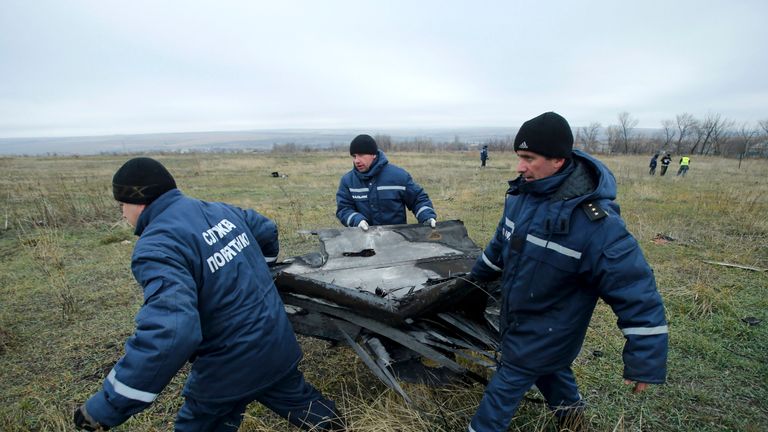MH17 crash: What we know so far - and what is still to come
Investigators are reportedly set to name four suspects over the downing of MH17 above eastern Ukraine in July 2014.
Wednesday 19 June 2019 11:11, UK
Almost five years after Flight MH17 was shot down above eastern Ukraine - killing all 298 passengers and crew on-board - an international team of investigators are set to reveal what progress has been made in a case that could lead to a criminal trial.
From Washington to Moscow, via London, Brussels and Amsterdam, intelligence analysts have been studying data and imagery to find out how and why the Malaysia Airlines plane - which was on its way to Kuala Lumpur from Amsterdam - came down in the war-torn region on 17 July 2014.
Prosecutors have refused to confirm reports that four people are set to be named as suspects, but the families of those who died seem assured of receiving more information about what caused the crash on Wednesday.
What we do know is that the investigating team - made up of top detectives and prosecutors from the Netherlands, Malaysia, Australia, Belgium and Ukraine - is convinced that the Buk missile system used to shoot down Flight MH17 came from the Russian 53rd Anti-Aircraft Missile brigade, based in the city of Kursk.
Russia has always denied responsibility for shooting down the flight and claimed last year that the Buk missile came from Ukrainian army arsenals, but the Netherlands and Australia have said they hold Moscow responsible for providing the missile system used.
Despite that assertion, overall progress in the criminal investigation has been slow until now.
Following the dangerous breakdown of relations between Ukraine and Russia, the Pentagon used its array of satellites in the area to constantly monitor ground activity.
Their analysts will have been looking for two things: a flash of light indicating a missile launch, or an ultra-violet trail.
If they can identify either, they should be able to track the trajectory of a missile and triangulate a launch site.
Under NATO orders, a UK E-3D Sentry aircraft was also operating there to monitor Russian and rebel movements, and if that had been in the air and within roughly 200 miles of the location, it would have picked up activity.
But according to Sky's defence correspondent Alistair Bunkall, the plane was not flying at the time.
If the investigators are right and the Boeing 777 jet was shot down, who did it, and how?
The most probable weapon is what NATO calls "the Grizzly": the SA-17 Buk 2.
It was designed and developed by the Russians back in the Cold War. It is fired from what is essentially the back of a big truck, and Buk systems are owned by both the Ukrainian and Russian militaries.
MH17 would have easily been within range, so the investigators' insistence that a Buk system was indeed responsible would seem well placed.
Another possibility that has been mooted in the years since the accident is that MH17 was downed by something known as MANPAD - shoulder-borne anti-aircraft missiles favoured by guerrilla groups around the world.
They are best used against low-flying aircraft with high heat signatures - helicopters, for example - and while they have been used to target commercial aircraft, it has only been done during take-off and landing.
Most importantly, they only have a range of about 4,572m (15,000ft). MH17, four hours into its flight, was at a cruising altitudes of more than 9,100m (30,000ft) - leaving it well out of range.
The key difference between MANPADS and Buk is that the latter uses radar, meaning that anyone operating it must be well-trained - this backs up the idea of state-lent soldiers to support the rebels.
Could this have been a mistake? Very possibly, even probably.
Strategically, you do have to wonder what any of the potential suspects - the Russians, Ukrainians, or rebels - have to gain by shooting down a Malaysian passenger plane.
One early theory is that the target could have been a Ukrainian military plane, and that the missile might have missed and then locked onto an alternative source.
Civilian aircraft are easy to identify. They broadcast a squawk which would be picked up by any weapons system trying to "paint" or lock on to it. They also fly well-known, clearly defined routes.
But unlike military aircraft, they have no warning systems. If a missile was locked on, and flying straight for them, they would have no clue, until it was too late.
Whatever happened, relatives of the passengers and crew aboard MH17 will be desperately hoping that the progress report on Wednesday will showcase some serious updates on the investigation.
Should any suspects be identified, Dutch officials have previously said that trials would take place in the Netherlands, under an agreement reached with the countries leading the investigation.
But if Russian suspects are charged, it remains to be seen if they ever appear for a trial. The Russian constitution bars the extradition of its nationals for trials abroad, meaning they can only be tried in their homeland.









